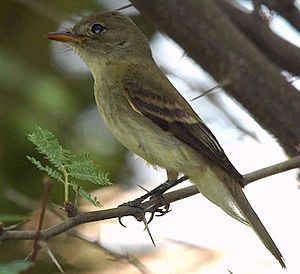Willow flycatcher facts for kids
Quick facts for kids Willow flycatcher |
|
|---|---|
 |
|
| E. t. extimus |
|
| Conservation status | |
| Scientific classification | |
| Genus: |
Empidonax
|
| Species: |
traillii
|

The willow flycatcher (Empidonax traillii) is a small bird that eats insects. It's a neotropical migratory bird, which means it travels long distances between its breeding grounds and its winter homes. This bird belongs to the tyrant flycatcher family.
There are four different types, or subspecies, of the willow flycatcher. All of them breed in North America. It can be very hard to tell Empidonax flycatchers apart just by looking at them. Because of this, scientists often listen to their songs to know which type they are. The bird's scientific name, traillii, honors a Scottish zoologist named Thomas Stewart Traill.
Contents
What Does the Willow Flycatcher Look Like?
Adult willow flycatchers are mostly brown-olive on their upper parts, with darker wings and tail. Their undersides are whitish. They have a faint white ring around their eyes and white stripes on their wings. Their beak is small, with a gray upper part and an orangish lower part. Their chest is a bit olive-gray.
For a while, people thought the willow flycatcher and the alder flycatcher were the same bird. They even called them "Traill's flycatcher" until the 1970s. The best way to tell them apart is by listening to their unique songs.
How Big Are They?
Here are some average measurements for the willow flycatcher:
| Standard Measurements | |
|---|---|
| Length | 130–150 mm (5.2–6 in) |
| Weight | 13.5 g (0.48 oz) |
| Wingspan | 220 mm (8.5 in) |
Where Do Willow Flycatchers Live?
Willow flycatchers build their nests in deciduous thickets, which are areas with many trees that lose their leaves in the fall. They especially like willow trees, often near water. They are found across the United States and southern Canada.
They build a cup-shaped nest in a vertical fork of a shrub or tree.
These birds are migratory. They travel to Mexico and Central America for the winter. Some even fly as far south as Ecuador in South America. They often choose winter homes near water. Willow flycatchers can travel between 1,500–8,000 km (930–4,970 mi) each way between their summer and winter homes.
What Do Willow Flycatchers Eat?
Willow flycatchers mainly eat insects. They often wait on a branch near the top of a shrub. When an insect flies by, they quickly fly out to catch it in the air. They also sometimes pick insects off leaves while hovering. They might eat some berries too.
Scientists have found common hoverflies (Syritta pipiens) in their droppings, showing these are part of their diet.
How Do They Communicate?
The song of the willow flycatcher sounds like a sneeze, often described as fitz-bew. Their call is a dry whit.
Willow Flycatcher Subspecies
The four subspecies of the willow flycatcher are best told apart by their songs. They also have important genetic differences. Scientists have used DNA studies to figure out where each subspecies spends its winter.
Here are the four recognized subspecies:
Little Willow Flycatcher (E. t. brewsteri)
This subspecies lives along the Pacific coast. It was first described by Harry C. Oberholser in 1918. It breeds in California, Oregon, and Washington, mostly west of the Cascade Mountains.
E. t. adastus
This subspecies breeds in the Great Basin and Northern Rocky Mountains. In California, it lives east of the Sierra Nevada and Cascade mountains. It was described by Harry C. Oberholser in 1932.
Southwestern Willow Flycatcher (E. t. extimus)
The southwestern willow flycatcher is a special subspecies because it is listed as a federally endangered species. This means it is at high risk of disappearing forever. It is found in states like Arizona, California, Colorado, Nevada, New Mexico, Texas, and Utah.
When it was listed as endangered in 1995, there were only about 75 known breeding spots. The total breeding population was estimated to be only 300 to 500 pairs. The largest remaining group in California is along the South Fork Kern River.
This subspecies is losing its home because of habitat loss and changes. Also, invasive species like saltcedar (Tamarix ramosissima) are taking over areas where the flycatchers live. Saltcedar outcompetes native plants that the flycatchers need.
However, there's good news! In some places, native trees have grown back, replacing saltcedar. When this happened, the number of willow flycatchers increased. Studies showed that 90% of their nests were in native plants. This shows how important native plants are for their survival.
The San Pedro River Preserve was bought by the Nature Conservancy to help protect the habitat for this subspecies. North American beavers are also helpful. They create wider river areas and open spaces in dense plants, which helps the flycatchers during their breeding season. This subspecies was described by A.R. Phillips in 1948.
E. t. traillii
This is the eastern subspecies of the willow flycatcher. It was described by John James Audubon in 1828. It breeds from the eastern coast of the United States all the way to the western Rocky Mountains.
See also
 In Spanish: Mosquero saucero para niños
In Spanish: Mosquero saucero para niños


